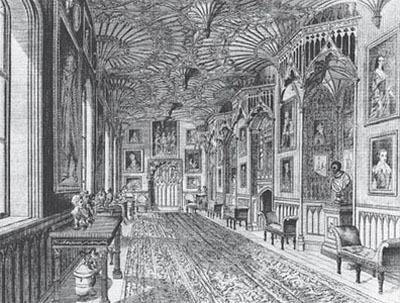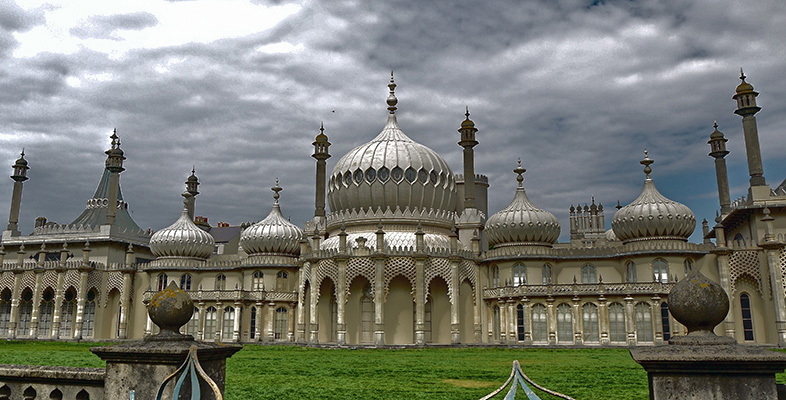4 ‘Chinese’ on the inside
Our evidence for the evolution of the Pavilion's interiors is largely derived from Augustus Pugin's watercolours of the building's interiors and exteriors, executed for a picture-book commissioned around 1820 by the house-proud prince from his architect John Nash, entitled Views of the Royal Pavilion, completed in 1826. On the whole, the Pavilion today has been restored to congruence with the Views, to appear as it did in 1823 when the building was finished. Let's now look at the Pavilion room by room, starting with the Octagon Hall, the Entrance Hall and the Long Gallery.
Exercise 5
Return to the video viewed at the start of this unit and to plates 3-5 (below) and take a careful look at the details of these three rooms. I'd like you to make notes in answer to the following questions:
What elements of the decoration are specifically Chinese?
What other elements of the decoration suggest fantasy architecture?
Click on 'View document' to see plates 3-5.
Click below to view clip 2 of the video, which features the Octagon Hall, the Entrance Hall and the Long Gallery.
Discussion
The Octagon Hall. Fashionably restrained in its colour scheme, this octagonal room none the less boasts two Chinese features – the little bells hanging from the ceiling and the central pendant lantern. Less specific is the elaborate reticulation of the cove and ceiling, gently suggesting a tent-like structure, a garden pleasure-pavilion.
The Entrance Hall. Chineseness is suggested most strongly by the dragons painted on the back-lit clerestory windows (which are, incidentally, echoed by dragons painted discreetly on the panels) and the lanterns at each corner. But, again, this is a restrained room in terms of its colour scheme, and it is strongly neoclassical in its insistence on certain symmetries, most notably in its provision of a false door to match the real door beside the fireplace.
The Long Gallery. In contrast to the preceding rooms, which suggest a style without setting definite expectations, the Long Gallery establishes without equivocation the Chinese theme that will be played out in so many different varieties of scale and feeling elsewhere in the building (Dinkel, 1983, p.78). Chinese features you might have picked out include the hexagonal lanterns, the silk tassels, the motif of bamboo and birds on the wallpaper, the bells lining the cornice, the Chinese figures and porcelain, the dragons and the Chinese god of thunder painted on the skylight, and the faux bamboo trellises projecting from the walls and ceiling and forming the banister and rails of the cast-iron staircase leading to the first floor. More nebulously, the colour scheme and the level of decoration are emphatically not neoclassical: the effect is of a riot of daringly clashing colours (pink, blue and scarlet, for example) and intricate geometric multicoloured decoration.
Much less Chinese, but certainly conducing to a fantasy effect, is the startling multiplication of cleverly placed mirrors in enfilade to produce a series of special effects. At four points along the corridor large opposing glasses create transverse vistas; in each recess a mirrored niche reflects a tall china pagoda where the lines of sight from one of the drawing rooms and from the corridor meet; and at the ends, where the corridor leads into the Music and Banqueting Rooms, double-doors entirely faced in mirror glass give a perspective of infinite repetition (Dinkel, 1983, p.81). (Contemporaries invariably remarked on the dazzling effect of the mirrors, and further evidence for the effect of the enfiladed mirrors in the Long Gallery is provided indirectly by the account of Soane's use of such mirrors in his country house, Pitzhanger Manor: he too thought they gave ‘magical effects’, but one of his guests did indeed mistake them for a corridor and was injured so badly that Soane felt obliged to have some of them removed to reduce the illusion – see Batey, 1995, p.23.)
One feature by which you may have been puzzled is the decoration along the cornice in the Entrance Hall, and indeed in the Banqueting Room Gallery, which is related (in miniature) to fan-vaulting. This owes more to the other contemporary fantasy style of Gothick than to those associated with the East. Put very briefly, Gothick simply sought to evoke (not very conscientiously) medieval church architecture, pretty much that of the so-called Perpendicular period of the first half of the fourteenth century. Strawberry Hill Gothick, so named after the home of Horace Walpole (1717–97), is especially lacy and fanciful, as you can see from the example in Figure 9.
So far, then, our tour of the Pavilion has identified three styles in use: the neoclassical (which dictates the symmetries of the rooms and their arrangements), the Gothick (which surfaces from time to time) and the Chinese. As we move into the main rooms, however, you should notice another set of references creeping in. We'll start by exploring the rest of the Pavilion, walking into the Music Room Gallery, the Saloon and the Banqueting Room, all originally used as drawing rooms – that is to say, the rooms to which the ladies withdrew to leave the men to drink their port, for coffee and liqueurs, for playing cards after dinner, and for occasional dancing, small concerts and recitals.
Exercise 6
Return to clip 3 of the video and continue your virtual tour concentrating on the Music Room Gallery, the Saloon and the Banqueting Room Gallery. By now your eye will be familiar, I hope, with the neoclassical, the Gothick and the Chinese, and you will have noted, for example, the Chinese fretwork, the neoclassical scheme of white and gilding characteristic of earlier interiors by the celebrated architect Robert Adam, and the cornice of tiny Gothick fan vaults. What other influence or influences might be at play here? (Clue: the decorative features that interest me here are principally the pillars in the Music and Banqueting Room Galleries and the tops of the mirrors in the Saloon.)
Click below to view clip 3 of the video.
Discussion
The pillars in the Banqueting Room Gallery are unmistakably meant to look like palm trees (which did not carry Chinese associations), and although the tops of the pillars in the Music Room Gallery look like the sort of Chinese umbrellas carried over high officials in imperial China, snakes rather than dragons curl round the columns. In the Saloon, the tops of the mirrors are unmistakably Mogul-inspired in their swelling forms. The mantelpiece and door-frames boast more snakes. There is, in short, a whiff of India about these three rooms, blended with the Chinese fantasy. (If you are especially sharp-eyed, you might also have noticed a faint flavour of the Egyptian in the furniture, especially in the shape of the river-boat couch with crocodile feet.)

The Saloon is, of course, where we started looking at the neoclassical Adamesque scheme portrayed in Rowlandson's sketch of c.1789; it is the inside of Holland's rotunda. By 1815 it had metamorphosed, courtesy of Crace, into a Chinese fantasy of a garden arbour, complete with a colourful trellis cornice hung with pendants, panels of Chinese wallpaper and Chinese lanterns. In 1823 Robert Jones swept all of this away in favour of sumptuous crimson, white and gold with an Indian edge. (In its present state it is not quite restored to the Jones scheme, so you should glance again at Plate 9 In evoking India, the Saloon spoke of empires, both Mogul and British, and as such is perhaps the key to the whole show.
Click on 'View document' to see plate 9, the Saloon.
What our investigation suggests is that the Pavilion increasingly displayed an eclectic confederation of styles: neoclassical, Gothick, Chinese and Indian. Some of the original furniture seems also to have had a distinctively Egyptian flavour. Contemporaries would not have been bothered or surprised by this.
Exercise 7
Click on 'View document' to open an extract from Maria Edgeworth's novel The Absentee.
Turn to the extract from Maria Edgeworth's novel The Absentee (above). The first part of this passage depicts an interview between an interior designer, Mr Soho, and a prospective client, Lady Clonbrony, a would-be social climber over from Ireland. They are discussing new decorations for the gala party which Lady Clonbrony fondly hopes will launch her as a leader of London society. Make a list of some of the more exotic styles Mr Soho is trying to sell.
Discussion
I have noted down that Mr Soho recommends furniture and hangings apparently inspired by a fantasy of the Middle East: ‘Turkish tent drapery’, ‘seraglio ottomans’ and other ‘Oriental’ furniture, ‘Alhambra hangings’ (which feature a dome), and ‘Trebisond trellice’ wallpaper. He also recommends ‘Egyptian hieroglyphic [wall]paper’ with an ‘ibis border’ which had at the time quite different connotations – of Napoleon's archaeological expeditions. He suggests too a ‘Chinese pagoda’. These recommendations, combined with the profusion of mythical and exotic animals and birds which he mentions as possible adornments (chimeras, griffins, cranes, sphinxes, phoenixes), make it clear that the Pavilion's fantasy world was more mainstream in temper than perhaps it looks nowadays – albeit much more expensive than Lady Clonbrony's temporary decor.
Edgeworth's Lady Clonbrony was destined for social mortification despite laying out her money on both the Turkish tent and the Chinese pagoda, but the association of these extreme styles with entertaining and with the display of a virtuoso and promiscuously exotic taste designed to secure social status is very much what the Pavilion was about.
We have now traversed the whole of Holland's Marine Pavilion, and before we turn our attention to Nash's extensions – the two extraordinary rooms that open from either end of the Long Gallery, the Banqueting Room (interior decoration by Robert Jones) and the Music Room (interior designed by Frederick Crace) – we need to catch up on the prince's projects for massive extension to his holiday home which began to gather speed in 1815.
